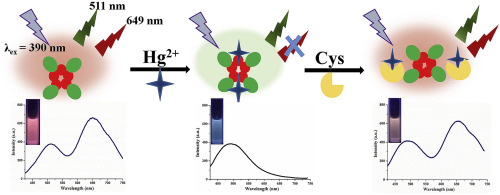当前位置:
X-MOL 学术
›
Anal. Chim. Acta
›
论文详情
Our official English website, www.x-mol.net, welcomes your
feedback! (Note: you will need to create a separate account there.)
Efficient Ratiometric Fluorescence Probe Utilizing Silicon Particles/Gold Nanoclusters Nanohybrid for “on-off-on” Bifunctional Detection and Cellular Imaging of Mercury (II) Ions and Cysteine
Analytica Chimica Acta ( IF 5.7 ) Pub Date : 2020-04-01 , DOI: 10.1016/j.aca.2020.01.020 Fan Ru , Peiyao Du , Xiaoquan Lu
Analytica Chimica Acta ( IF 5.7 ) Pub Date : 2020-04-01 , DOI: 10.1016/j.aca.2020.01.020 Fan Ru , Peiyao Du , Xiaoquan Lu

|
An effective ratiometric fluorescent probe based on silicon particles/gold nanoclusters (SiNPs/AuNCs) nanohybrid has been fabricated and applied to be a "on-off-on" switch sensing platform for detection of Hg2+ and cysteine. In this elaborated sensing platform, the SiNPs just acted as internal reference signal, providing a build-in correction for background interferences and environmental effects, to which the AuNCs as a signal report unit for Hg2+ response was covalently grafted by amidation reaction. The fluorescence intensity of SiNPs/AuNCs could be effectively quenched upon adding Hg2+, accompanied with an easily distinguishable fluorescent color change. The ratiometric fluorescence signal (F649/F511) of the established nanoprobe was linearly proportional to the concentration of Hg2+ ranging from 0.02 to 24 μM with a low detection limit of 5.6 nM, which is below the guideline value of Hg2+ in drinking water set by the World Health Organization. Interestingly, upon addition of cysteine, the Hg2+-quenched fluorescence intensity was recovered gradually. Furthermore, the approach developed has also been utilized for Hg2+ detection in real complex biological samples with satisfactory results. More importantly, benefiting from the good water-solubility and excellent biocompatibility, this nanoprobe can monitor the intracellular Hg2+ and cysteine in living cells, indicating its potential applications in advanced biosensing and bioimaging.
中文翻译:

利用硅粒子/金纳米团簇纳米杂化物进行汞 (II) 离子和半胱氨酸的“开-关-开”双功能检测和细胞成像的高效比率荧光探针
一种基于硅颗粒/金纳米团簇(SiNPs/AuNCs)纳米杂化物的有效比例荧光探针已被制造并应用为“开-关-开”开关传感平台,用于检测 Hg2+ 和半胱氨酸。在这个精心设计的传感平台中,SiNPs 只是作为内部参考信号,为背景干扰和环境影响提供内置校正,作为 Hg2+ 响应的信号报告单元的 AuNCs 通过酰胺化反应共价接枝。添加 Hg2+ 后,SiNPs/AuNCs 的荧光强度可以被有效淬灭,并伴随着易于区分的荧光颜色变化。已建立的纳米探针的比率荧光信号 (F649/F511) 与 Hg2+ 的浓度成线性比例,范围为 0。02 至 24 μM,检测下限为 5.6 nM,低于世界卫生组织设定的饮用水中 Hg2+ 的指导值。有趣的是,加入半胱氨酸后,Hg2+ 淬灭的荧光强度逐渐恢复。此外,所开发的方法也已用于实际复杂生物样品中的 Hg2+ 检测,结果令人满意。更重要的是,得益于良好的水溶性和优异的生物相容性,该纳米探针可以监测活细胞中的细胞内 Hg2+ 和半胱氨酸,表明其在先进的生物传感和生物成像方面具有潜在的应用价值。Hg2+-淬灭的荧光强度逐渐恢复。此外,所开发的方法也已用于实际复杂生物样品中的 Hg2+ 检测,结果令人满意。更重要的是,得益于良好的水溶性和优异的生物相容性,该纳米探针可以监测活细胞中的细胞内 Hg2+ 和半胱氨酸,表明其在先进的生物传感和生物成像方面具有潜在的应用价值。Hg2+-淬灭的荧光强度逐渐恢复。此外,所开发的方法也已用于实际复杂生物样品中的 Hg2+ 检测,结果令人满意。更重要的是,得益于良好的水溶性和优异的生物相容性,该纳米探针可以监测活细胞中的细胞内 Hg2+ 和半胱氨酸,表明其在先进的生物传感和生物成像方面具有潜在的应用价值。
更新日期:2020-04-01
中文翻译:

利用硅粒子/金纳米团簇纳米杂化物进行汞 (II) 离子和半胱氨酸的“开-关-开”双功能检测和细胞成像的高效比率荧光探针
一种基于硅颗粒/金纳米团簇(SiNPs/AuNCs)纳米杂化物的有效比例荧光探针已被制造并应用为“开-关-开”开关传感平台,用于检测 Hg2+ 和半胱氨酸。在这个精心设计的传感平台中,SiNPs 只是作为内部参考信号,为背景干扰和环境影响提供内置校正,作为 Hg2+ 响应的信号报告单元的 AuNCs 通过酰胺化反应共价接枝。添加 Hg2+ 后,SiNPs/AuNCs 的荧光强度可以被有效淬灭,并伴随着易于区分的荧光颜色变化。已建立的纳米探针的比率荧光信号 (F649/F511) 与 Hg2+ 的浓度成线性比例,范围为 0。02 至 24 μM,检测下限为 5.6 nM,低于世界卫生组织设定的饮用水中 Hg2+ 的指导值。有趣的是,加入半胱氨酸后,Hg2+ 淬灭的荧光强度逐渐恢复。此外,所开发的方法也已用于实际复杂生物样品中的 Hg2+ 检测,结果令人满意。更重要的是,得益于良好的水溶性和优异的生物相容性,该纳米探针可以监测活细胞中的细胞内 Hg2+ 和半胱氨酸,表明其在先进的生物传感和生物成像方面具有潜在的应用价值。Hg2+-淬灭的荧光强度逐渐恢复。此外,所开发的方法也已用于实际复杂生物样品中的 Hg2+ 检测,结果令人满意。更重要的是,得益于良好的水溶性和优异的生物相容性,该纳米探针可以监测活细胞中的细胞内 Hg2+ 和半胱氨酸,表明其在先进的生物传感和生物成像方面具有潜在的应用价值。Hg2+-淬灭的荧光强度逐渐恢复。此外,所开发的方法也已用于实际复杂生物样品中的 Hg2+ 检测,结果令人满意。更重要的是,得益于良好的水溶性和优异的生物相容性,该纳米探针可以监测活细胞中的细胞内 Hg2+ 和半胱氨酸,表明其在先进的生物传感和生物成像方面具有潜在的应用价值。











































 京公网安备 11010802027423号
京公网安备 11010802027423号